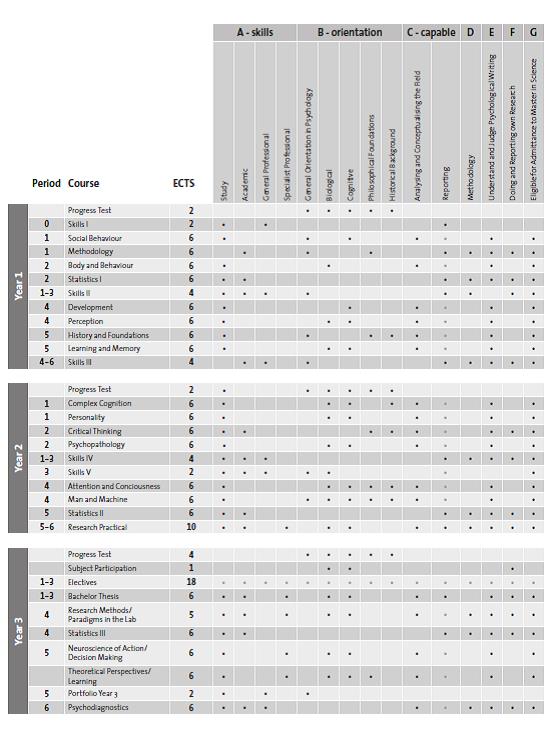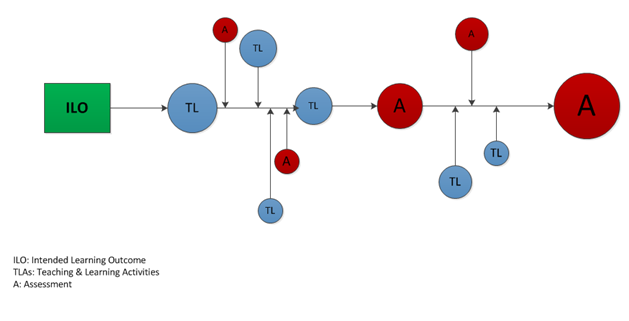Intended Learning Outcomes
This page deals with ILOs in general. For the implications of ILOs on specific levels (course, programme, institutional), please navigate via the buttons above.
The first step in the design of constructively aligned teaching and assessment is defining intended learning outcomes (ILOs).
Well formulated ILOs lie at the basis of any learning process and appear in course and educational programme descriptions. Once you are given the task to design ILOs, you will find out that it is very difficult to formulate them. It is much easier to formulate the topics to be studied, but if you have to define the exact level to which the topic is to be studied, and if you need to define exactly what a student should be able to do, if true understanding of the topic is achieved, it becomes complicated.

All ILOs on course, programme and institutional level need to be aligned.
Aligning programme and institutional ILOs can be done by listing all ILOs in e.g. a curriculum map (see next tab), and checking how each programme ILO reflects an institutional ILO. However, according to Biggs & Tang (2007), not all graduate attributes need to be addressed individually in the programme ILOs. They state that some graduate attributes may not be relevant for each particular programme or discipline.
Next the programme and course ILOs should be aligned. This can be done by firstly evaluating per course how the course ILOs address the programme ILOs. Secondly, this linkage between course and programme ILOs of all courses needs to be evaluated on programme level by considering whether:
- all programme ILOs are addressed;
- the alignment is balanced (no overemphasize);
- there are no programme ILOs that are not (sufficiently) being addressed.
A curriculum map provides an overview of all education activities, didactic aims and competences developed in a curriculum. This therefore supports the organisation of a constructively aligned curriculum. Below you can view an example of a good curriculum map.

Based on the ‘1 on 1-development’ of ILOs, courses and assessment, the longitudinal development of ILOs should be taken into account. There is more complexity and development possible with ILOs that are addressed in multiple courses. Similarly, a test can assess multiple ILOs. The figure below shows the effect of the longitudinal integration of ILOs/teaching and learning activities (TLAs)/ Assessment (Ass.) in a curriculum.

1. Who guards the alignment between course and programme ILOs?
The best person to coordinate the programme ILOs and the linkage between course and programme ILOs is the programme director.
2. Evaluate per course how the course ILOs address the programme ILOs?
See tab ‘curriculum map’
3. Are all programme ILOs addressed throughout the courses?
Consider whether:
- all programme ILOs are addressed;
- the alignment is balanced (no overemphasize);
- there are no gaps of programme ILOs not (sufficiently) being addressed.
Consider using curriculum maps to gain a good overview of the alignment.
4. Is the alignment balanced? (e.g. no overemphasis on specific topics)
If a topic is overemphasized, you should consider how to regain balance. Probably there is room to address other (innovative) topics at some points in your curriculum.
5. Are there no gaps of programme ILOs not (sufficiently) being addressed?
If a topic doesn’t get enough attention within your curriculum, you can search for possibilities to adjust this.
The NVAO document ‘Assessment and Demonstration of Achieved Learning Outcomes: Recommendations and Good Practices’, published on February 2016, has listed some practical recommendations with respect to ILOs.
Recommendation 1: It is all about learning outcomes – consider intended and achieved learning outcomes as two sides of the same coin
- Keep it simple.
- Implement learning outcomes in the course of regular development and improvement of education.
- Use simple rules of thumb in the definition of learning outcomes (e.g. “start with a verb”); make them student-focused and measurable.
- Use to the language of the teachers and avoid discussions on semantics or methodology.
- Make sure learning outcomes cover the important elements in a programme, but do not try to be too detailed.
- Involve all stakeholders in the formulation of outcomes, both internal – teachers and students, as well as external – the professional field and prospective employers.
- Make sure that the formats of teaching and the assessment align with the intended learning outcomes.
- Calibrate the difference between learning outcomes at the level of ‘short cycle?’, ‘bachelor’, and ‘master’.
- Learning outcomes at lower levels should be defined on their own terms and not as ‘light’ versions of those at a higher level.
- Learning outcomes tend to be more detailed for programmes with a strong professional orientation. Allow enough freedom for teachers and for innovation.
- Pay attention to generic, transversal competences, which are overly generic and lack a connection with domain-specific learning outcomes, as this makes them hard to transfer. This also goes for ‘21-st century skills’, which require integration of knowledge and skills from the traditional domains.
Recommendation 2: Use learning outcomes as a tool for developing and improving education, not as a goal in itself
- Learning outcomes should be a ‘living’ element and shape the formats of curricula, courses, teaching, learning and assessment. Define and implement them in a process of team-based co-creation, not as an administrative obligation.
- Maintain a good balance between making learning outcomes conform to external qualification frameworks and expectations in the professional field and autonomy for teachers and institutions.
